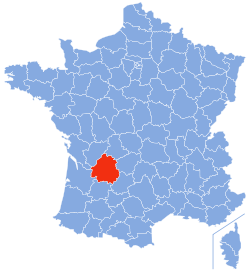Dordogne (département)
| Dordogne | |||
|---|---|---|---|
| Department | |||

Prefecture building of the Dordogne department, in Périgueux
|
|||
|
|||
 Location of Dordogne in France |
|||
| Coordinates: 45°0′N 0°40′E / 45.000°N 0.667°ECoordinates: 45°0′N 0°40′E / 45.000°N 0.667°E | |||
| Country | France | ||
| Region | Nouvelle-Aquitaine | ||
| Prefecture | Périgueux | ||
| Subprefectures |
Bergerac Nontron Sarlat-la-Canéda |
||
| Government | |||
| • President of the General Council | Germinal Peiro (PS) | ||
| Area | |||
| • Total | 9,060 km2 (3,500 sq mi) | ||
| Population (2013) | |||
| • Total | 416,909 | ||
| • Rank | 58th | ||
| • Density | 46/km2 (120/sq mi) | ||
| Time zone | CET (UTC+1) | ||
| • Summer (DST) | CEST (UTC+2) | ||
| Department number | 24 | ||
| Arrondissements | 4 | ||
| Cantons | 25 | ||
| Communes | 545 | ||
| ^1 French Land Register data, which exclude estuaries, and lakes, ponds, and glaciers larger than 1 km2 | |||
Dordogne (French pronunciation: [dɔʁ.dɔɲ]; Occitan: Dordonha) is a department in southwestern France, with its prefecture in Périgueux. The department is located in the region of Nouvelle-Aquitaine between the Loire Valley and the Pyrenees, and is named after the great Dordogne river that runs through it. It roughly corresponds with the ancient county of Périgord.
The county of Périgord dates back to when the area was inhabited by the Gauls. It was originally home to four tribes, the name for "four tribes" in the Gaulish language was "Petrocore". The area eventually became known as the county of Le Périgord and its inhabitants became known as the Périgordins (or Périgourdins). There are four Périgords in the Dordogne: the "Périgord Vert" (Green Périgord) with its main town of Nontron, consists of verdant valleys in a region crossed by many rivers and streams; the "Périgord Blanc" (White Périgord) situated around the department's capital of Périgueux, is a region of limestone plateaux, wide valleys and meadows; the "Périgord Pourpre" (Purple Périgord) with its capital of Bergerac, is a wine region; and the "Périgord Noir" (Black Périgord) surrounding the administrative center of Sarlat, overlooks the valleys of the Vézère and the Dordogne, where the woods of oak and pine give it its name.
The Petrocores took part in the resistance against Rome. Concentrated in a few major sites are the vestiges of the Gallo-Roman period-–the gigantic ruined tower and arenas in Périgueux (formerly Vesone), the Périgord museum's archaeological collections, villa remains in Montcaret and the Roman tower of La Rigale Castle in Villetoureix. The earliest cluzeaux, artificial caves either above or below ground, can be found throughout the Dordogne. These subterranean refuges and lookout huts were large enough to shelter entire local populations. According to Julius Caesar the Gauls took refuge in these caves during the resistance.
...
Wikipedia


